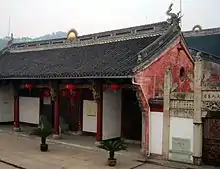
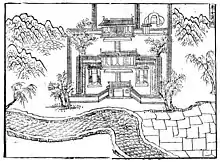
The Cao'e Temple (Chinese: 曹娥庙) was built to honor Cao E, a young girl who was drowned when she tried to save her father in an act of filial piety. The temple was built for the first time in the year 151, and has been relocated, rebuild, restored and expanded several times. The last time this temple was rebuilt was in 1929 after a huge fire, the restoration lasted until 1936.[1][2]
Location and description
The Cao'e Temple is situated in the Shangyu District, Shaoxing, Zhejiang Province, China.[3] The temple faces to the east and overlooks the Cao'e River, with on the rear side of the temple a view of the Phoenix mountain. The temple is built on an area of 6000 square meters, the temple itself measures 3840 square meters. Inside the temple, several wall paintings have been created describing the story of Cao E. The temple has been built with many stone carving and wood carving.[4][5]
In 1093 Emperor Song Zhezong had a main hall built in the temple. There are more than 30 steles donated by famous people and exhibited in the temple in honor of Cao E, some of these famous people are: Mi Fu, Tang Yin, Zhu Yunming, Wen Zhengming, Chiang Kai-shek.
Cultural
The Cao'e Temple has a rich cultural heritage of nearly 2,000 years and has a high artistic taste, and is renowned at home and abroad for its carvings, murals, couplets and calligraphy. Since 1989, the Cao'e Temple has been included in the list of protected national and cultural relics. Every year from May 15–22, there is a festival in the Cao'e Temple, with a Cao E memorial service at the temple on May 22. The temple is called the first temple of Jiangnan.[6]
Photo Gallery
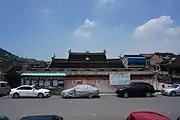 The skyline of the complex
The skyline of the complex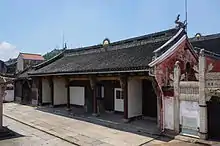 The Façade of the temple looking east over the Cao'e River
The Façade of the temple looking east over the Cao'e River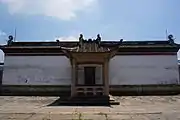 The western side of the façade and the Royal Tablet Pavilion
The western side of the façade and the Royal Tablet Pavilion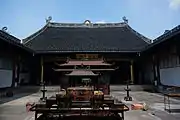 The main hall
The main hall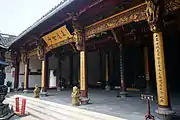 A closer view of the main hall
A closer view of the main hall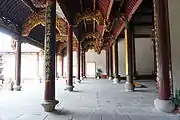 The front of the main hall
The front of the main hall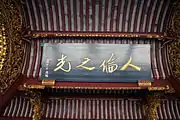 Plaque inscribed by Jiang Zhongzheng with the title 'The Light of Humanity'
Plaque inscribed by Jiang Zhongzheng with the title 'The Light of Humanity'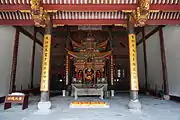 Interior view of the main hall, with the statue of Cao'e in a pavilion
Interior view of the main hall, with the statue of Cao'e in a pavilion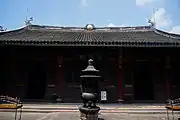 Rear Hall
Rear Hall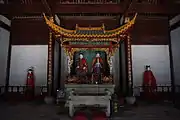 Interior view of the back hall, with the statue of Cao'e's parents in a pavilion, flanked by statues
Interior view of the back hall, with the statue of Cao'e's parents in a pavilion, flanked by statues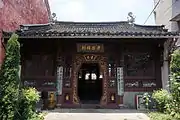 The Pavilion on the Northern Axis
The Pavilion on the Northern Axis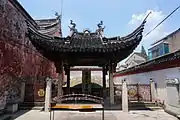 Cao'e's tomb on the northern axis
Cao'e's tomb on the northern axis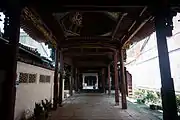 The Southern Axis of the Corridor
The Southern Axis of the Corridor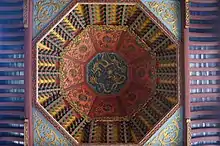 A well on the corridor
A well on the corridor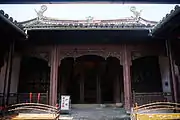 Yan Wang Hall on the Southern Axis
Yan Wang Hall on the Southern Axis
References and notes
- ↑ "Cao'e Temple" (in Chinese). Zhejiang Provincial Bureau of Cultural Relics. 2021-12-03. Archived from the original on 30 October 2014.
- ↑ 马志坚 (2009). 人伦之光: 江南第一庙·曹娥庙 (in Chinese). ISBN 9787534027017. Ma Zhijian (2009). The Light of Human Relations: The First Temple in Jiangnan, Cao'e Temple). ISBN 9787534027017. Retrieved February 9, 2022.
- ↑ Park Hyun Kyu (2012). "Trace of Goryeo(高麗) envoy and their role in the Cao E shrine(曹娥廟), Shangyu(上虞)". Noordoost-Aziatische culturele studies. Noordoost-Aziatische Culturele Vereniging. 1 (32): 211–226. doi:10.17949/jneac.1.32.201209.012. Retrieved February 9, 2022.
- ↑ ""江南第一庙"-----曹娥庙" (in Chinese). 上虞图书馆. "Translation:The first temple in the south of the Yangtze River - Cao'e Temple". Shangyu Library. Retrieved February 9, 2022.
- ↑ "曹娥庙". Archived from the original on 2022-02-09. Retrieved 2022-02-09. "Translation: Cao E Temple". Chinese Encyclopedie Online. Retrieved February 9, 2022.
- ↑ "曹娥庙景区" (in Chinese). "Translation: Cao'e Temple Scenic Spot". Shaoxing Municipal People's Government. Retrieved February 9, 2022.
Website
- "Official website of the Cao'e Temple". Archived from the original on 2013-08-13.